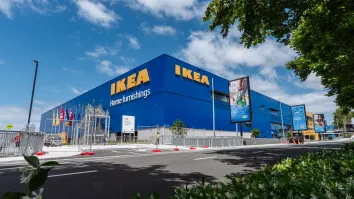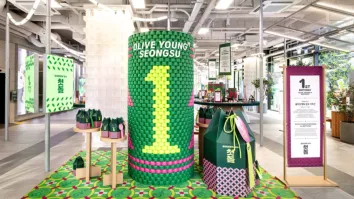Leverage AI & machine learning to rejuvenate retail business
New technologies are often seen as a source of disruption in the retail industry; however, new technologies that can enhance shoppers’ experience also present a huge opportunity to retailers. As we usher in the new year, what are some important technology concepts retailers should be aware of and embrace to survive the impact of the borderless world of modern retailing? Retail Asia’s Muneerah Bee contacts retail professionals, researchers and solutions providers to file this report.
Artificial Intelligence (AI) is essentially intelligence displayed by machines. Deep learning, on the other hand, is a machine-learning technique that involves making a computer learn by feeding it with lots of data.
According to Takeshi Umiyama, managing director of optical store OWNDAYS, these two concepts are closely related and can be interpreted in this manner: Deep learning is the process or methodology to achieve the outcome, which is AI.
Looking ahead, how can retailers leverage AI to improve their operations and connect with their customers?
Umiyama says: “Managing supply chain is always a key challenge in the retail business. With AI, a retail company will be able to better manage its inventory and logistics through streamlining processes and cutting costs.
“In addition, AI and deep learning can contribute to customer relationship management. They help a retailer understand and cater to the needs of its customers better.” “OWNDAYS has adopted deep learning to build a tool that aids us in our eye check processes.
“As a quick-service, fast-fashion eyewear retailer, we sell more than two million pairs of glasses annually on a global scale. As such, we are able to collect a huge pool of data on customers’ prescriptions.
“Using deep learning, we are able to utilise this data and convert it into an AI system, which we use as a reference in finding the most suitable lens power for customers during eye checks,” Umiyama explains.
Jonathan Cummings, chairman of Fitch Hong Kong as well as group business director of the retail and brand consultancy, adds: “As convenience and experience become more popularised, AI will come into the mainstream to facilitate higher levels of agility and service for retailers.
“And this is not all about self service. AI can, and will, enable store staff to provide higher levels of service too.”
Albert Antoine, senior vice president, Asia-Pacific, of computer software company Dataiku, notes: “Retailers have always been relying heavily on data, but new developments in the machine learning and predictive analytics space are poised to open up huge opportunities in the way stores and it can fundamentally improve operations and serve customers better.
“Moving into the new year, retailers that embrace technologies should be able to use data in combination with a modern data science tool set to increase customer satisfaction and profit margins.”
He maintains that leveraging machine learning and predictive analytics in today’s competitive environment is all about understanding customers at a deeper level as customers today make purchasing decisions based on a wide variety of reasons and, more often than not, repeat business is directly related to the seller-buyer relationship.
Antoine firmly believes that engaging customers and providing them with specific goods and services that they want is a key component of creating loyal customers. This can be done by leveraging machine learning and predictive analytics to identify what individual customers want by combining and finding patterns in huge swaths of available data.
“Retail, and e-commerce in particular, has massive quantities of varied data at its fingertips for analysis — perfect for machine learning and predictive analytics.
“It includes data sets such as historic sales data, consumer demand data, price variance data, lead rates, trends, social media, customer feedback, weblogs, online buying behaviour, website usage and loyalty programmes.
“The sheer quantity of data stops most companies in their tracks; they want to take advantage of the information but do not know where to begin.”
He adds that predictive analytics empowers organisations to gain a much deeper understanding of markets and competitions, effectively using a wide variety of raw data to predict the most likely outcome. Historic sales data, the weather, social media content, and even traffic data can all combine in different ways to paint a picture of what customers are looking for and when they want it.
Foo Mao Gen, head of Southeast Asia, Qualtrics (an experience management company), agrees, adding: “Powered by machine learning and AI, predictive analytics allows organisations to democratise their ability to move from data to insights. In other words, retailers can extract information from data such as customers’ profiles collected and using it to predict trends and behaviour patterns.”
What’s next after omni-channel?
The next step from an omni-channel strategy is converged commerce — a single-selling platform with shared data and services such as customer, product, promotions, tenders and tax, suggests Cas Brentjens, Solution Consulting director for Asia-Pacific and Japan at Infor, an enterprise software provider.
“Channel-specific experiences need to be designed on top of the platform to support in-store point-of-sale (POS), mobile devices, and online purchasing data.
“Not only does this deliver a more consistent experience for consumers, but retailers also won’t have to duplicate efforts adjusting channel-specific data or processes.
“All the consumer touchpoints are managed together. Under this strategy, retailers must leverage technology tools such as data analytics and enterprise solutions that manage their inventories and supply chains in real time,” he explains.
This will allow retailers to respond quickly to customer demands and update their manufacturing and supply processes, says Brentjens, adding that it will improve the speed of delivery, demand planning, stock replenishment and price competitiveness — and this will also allow retailers to deliver highly personaliased website content and recommendations based on data from all customers’ online and offline interactions.
A converged commerce retail strategy will help to boost customer loyalty and attract new customers, as it will enable retailers to respond quickly to changes in consumer demands, thus curating a distinctive shopping experience across online and bricks-and-mortar stores.
Collecting and analysing data from a customer’s online and offline interactions can also improve engagement rates between a retailer and its target customers.
Brentjens says: “Sophisticated data solutions are already in the market, automating all the processes mentioned above. It is now the time for retailers to invest in such technologies to boost their competitiveness in 2018.”
Qualtrics’ Foo offers another thought in the collection of data. He says: “Retailers today are awashed with operational data (O data), which tells you what has happened.
“What they need to start collecting is experience data (X data), which will allow them to garner insights into why things are happening.”
This will lead to ‘experience management’, which helps organisations to focus on how to measure, prioritise and optimise the experiences they provide across the four foundational aspects of business — customer, employee, brand and product.
According to a Bain & Company study, 80% of CEOs believe that they are delivering a superior experience, but only 8% of their customers agree!
This highlights an experience gap — the gap between what organisations actually deliver and expectations from the market, customers as well as employees.
As experience increasingly becomes a key differentiator for top brands in Asia-Pacific, it is vital for Asian retailers to increase their efforts across all customer touchpoints and sharpens experience management to achieve business success, Foo maintains.
While many retail professionals are talking about emerging or cutting-edge technologies, a company has adopted ‘old’ radio-frequency identification (RFID) technology to enhance its service offerings.
Decks, an apparel supplier to department stores in Singapore, will be launching a ‘Smart Fitting Room’ in its Island Shop in Tanglin Mall in June 2018.
Kelvyn Chee, managing director of Decks, shares: “This idea came about from the logic that the most important conversion area — and the least serviced area — in apparel retail is the fitting room.
“With better understanding and use of technology, the simple RFID reader can sense the items that a customer brings into the fitting room and suggest matching tops or bottoms to the customer. The LED display screen in the room can then allow touchscreen input by the customer to request for a particular size and colour so that the salesperson could bring the apparel to him or her.
“The customer will not have to queue for a fitting room again, or leave the fitting room to get another item. Hence, enhancing the overall customer experience.
“Another plus point is that the LED display can suggest matching clothes and accessories that the customer is trying on.”
Decks is reportedly among the first retailers in Singapore to implement RFID full scale and integrate the RFID system with its front-end cashiering processes.
“The technology proved beneficial for us as it reduced the time taken for stocktaking by 95% and the replenishment of stocks by 95% as well.
“The use of such technology has helped the company to re-define productivity and simplify work processes,” says Chee, adding that the RFID system also proved useful when Decks acquired Island Shop two years ago as the office and the logistics personnel was increased by only two headcount although revenue was up by almost 40%.
“Our company is a huge believer of keeping up to date with technology and hopes to leverage the trend of being one of the first movers to benefit from innovative usage of RFID.
“Moving forward into 2018, the company hopes to maintain the company slogan, which is ‘Re-define productivity, recreate work process and simplify job scope with the employee mindset’,” says Chee.
While bricks-and-mortar stores have evolved and improved their customer service, the new generation of consumers are trading in-store shopping excursions in favour of rich digital experiences.
Analyst firm IDC predicts that by the year 2020, 40% of leading brands will offer shoppers digital experiences — in-store and beyond — to enhance retailers’ offerings with augmented digital properties that are visible to mobile technology users.
In 2018, retailers in South-east Asia should embrace and experiment with new digital technologies to complement in-store customers’ personal experiences, opines Omer Ali Khan, general manager, ASEAN, Avanade, a digital and cloud service provider. These include augmented and virtual reality (AR/VR) experiences for trying on clothes, virtual assistants providing customer service via chatbots and interactive merchandise tables in stores and supermarkets. Avanade recently conducted a survey to find out whether consumers perceived virtual assistants are doing a better job than interns and part-timers helping out during holiday seasons.
“More than 50% of retailers we surveyed plan to use AR/VR and robotics in their stores in the next one to two years, and it’s important to understand the impact of those technologies on the workforce,” says Khan. “Digital tools that help train staff and provide personalised employee experiences are as important as those that engage the customer.”
Last but not least, retailers should take note of Internet of Things (IoT).
For now, IoT is a term used to describe the increased connectivity of items apart from just computers and smartphones.
“Obviously, the ability to reach customers in this way is good news for retailers, but more importantly, IoT also has the ability to drive new efficiencies in retailers’ operations,” says Jeff Steilen, vice-president, Information Technology, UPS Asia-Pacific.
For example, the use of sensors on the shelves of stores and warehouses has the ability to drive greater operational efficiencies, where product ordering and supply chain management is done
almost entirely by automated systems.
As a sensor detects that a certain product is running low, it sends a signal to a stock monitoring system, which then makes a purchase automatically from a supplier, and coordinates delivery with a logistics partner.
“Systems like this in retail could reshape how human resources are invested — less in stock management and more in customer service.”
As online shoppers become increasingly demanding and impatient, and the walls come down between online and offline retail, IoT technologies will help businesses to tighten the links between all aspects of their operations, enabling them to gain an edge over the competition by delivering goods to and from their suppliers and customers faster, cheaper and more conveniently.
Steilen relates an out-of-the-box example of IoT from China where Starbucks, Häagen-Dazs and other restaurants use sensors to detect how busy their stores are so they can change the genre of music accordingly — when busy, fast-paced music is played to drive quicker movement of customers, and when it’s less busy, more laid-back tracks are selected to encourage customers to linger a bit longer and perhaps, enjoy another cup of coffee or ice-cream.
“This is a very simple example, but one that highlights how the clever use of IoT does not need to revolutionise how your business works — you just need to consider how connectivity can make life a little easier for you and your customers,” explains Steilen.



















 Advertise
Advertise







